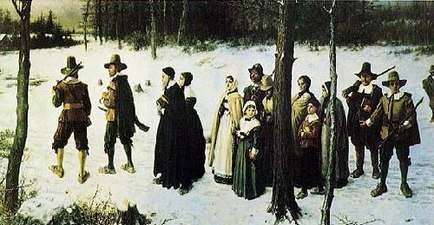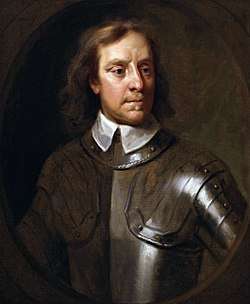Puritans
| Part of a series on |
| Puritans |
|---|
|
Elsewhere |
|
Continuing movements |
| Part of a series on |
| Protestantism |
|---|
 |
|
Minor branches |
|
Interdenominational movements |
|
Related movements |
The Puritans were English Reformed Protestants in the 16th and 17th centuries who sought to "purify" the Church of England from its "Catholic" practices, maintaining that the Church of England was only partially reformed.[1] Puritanism played a significant role in English history, especially during The Protectorate.
The Puritans were in alliance with the growing commercial world, the parliamentary opposition to the royal prerogative, and the Scottish Presbyterians in the late 1630s with whom they had much in common. Consequently, they became a major political force in England and came to power as a result of the First English Civil War (1642–46). Almost all Puritan clergy left the Church of England after the Restoration of 1660 and the 1662 Uniformity Act. Many continued to practice their faith in nonconformist denominations, especially in Congregationalist and Presbyterian churches.[2] The nature of the movement in England changed radically, although it retained its character for a much longer period in New England.
Puritans by definition were dissatisfied with the limited extent of the English Reformation and with the Church of England's tolerance of practices which they associated with the Catholic Church. They formed and identified with various religious groups advocating greater purity of worship and doctrine, as well as personal and group piety. Puritans adopted a Reformed theology and, in that sense, were Calvinists (as were many of their earlier opponents). They also took note of radical criticisms of Zwingli in Zürich and Calvin in Geneva. In church polity, some advocated separation from all other established Christian denominations in favour of autonomous gathered churches. These separatist and independent strands of Puritanism became prominent in the 1640s, when the supporters of a Presbyterian polity in the Westminster Assembly were unable to forge a new English national church.
Puritanism was never a formally defined religious division within Protestantism, and the term Puritan itself was rarely used after the turn of the 18th century. Some Puritan ideals became incorporated into the Church of England, such as the formal rejection of Roman Catholicism; others were absorbed into the many Protestant denominations that emerged in the late 17th and early 18th centuries in America and Britain. The Congregationalist churches, widely considered to be a part of the Reformed tradition, are descended from the Puritans.[3][4] Moreover, Puritan beliefs are enshrined in the Savoy Declaration, the confession of faith held by the Congregationalist churches.[5]
Terminology
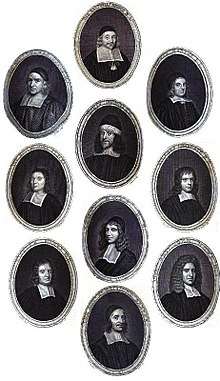
In the 17th century, the word Puritan was a term applied to not just one group but many. There continues to be debate among historians over the definition of Puritanism.[6] Historically, the word Puritan was considered a pejorative term that characterized Protestant groups as extremists. According to Thomas Fuller in his Church History, the term dates to 1564. Archbishop Matthew Parker of that time used it and precisian with the sense of the modern stickler.[7] Puritans, then, were distinguished for being "more intensely protestant than their protestant neighbors or even the Church of England".[8]
Some Puritans are known as "non-separating Puritans", those who were not satisfied with the Reformation of the Church of England but who remained within it, advocating further reforms. This group disagreed among themselves about how much further reformation was possible or even necessary. Others thought that the Church of England was so corrupt that true Christians should separate from it altogether; they are known as "separating Puritans" or simply "Separatists". The term Puritan in the wider sense includes both groups.[9][10]
Puritans should not be confused with more radical Protestant groups of the 16th and 17th centuries, such as Quakers, Seekers, and Familists. These groups taught that individuals could be directly guided by the Holy Spirit and prioritized direct revelation over the Bible.[11]
In modern times, puritan is often used to mean "against pleasure". In this usage, hedonism and puritanism are antonyms.[12] In fact, Puritans embraced sexuality but placed it in the context of marriage. Peter Gay writes of the Puritans' standard reputation for "dour prudery" as a "misreading that went unquestioned in the nineteenth century", commenting how unpuritanical they were in favour of married sexuality, and in opposition to the Catholic veneration of virginity, citing Edward Taylor and John Cotton.[13] One Puritan settlement in Western Massachusetts banished a husband and sent him into exile because he refused to fulfill his marital duties to his wife.[14]
History
Puritanism has a historical importance over a period of a century, followed by 50 years of development in New England. It changed character and emphasis almost decade-by-decade over that time.
Elizabethan Puritanism
Elizabethan Puritanism contended with the Elizabethan religious settlement, with little to show for it. The Lambeth Articles of 1595, a high-water mark for Calvinism within the Church of England, failed to receive royal approval.
Jacobean Puritanism
The accession of James I brought the Millenary Petition, a Puritan manifesto of 1603 for reform of the English church, but James wanted a new religious settlement along different lines. He called the Hampton Court Conference in 1604, and heard the teachings of four prominent Puritan leaders there, including Laurence Chaderton, but largely sided with his bishops. He was well informed on theological matters by his education and Scottish upbringing, and he dealt shortly with the peevish legacy of Elizabethan Puritanism, pursuing an eirenic religious policy, in which he was arbiter.
Many of his episcopal appointments were Calvinists, notably James Montague, who was an influential courtier. Puritans still opposed much of the Catholic summation in the Church of England, notably the Book of Common Prayer, but also the use of non-secular vestments (cap and gown) during services, the sign of the Cross in baptism, and kneeling to receive Holy Communion.[15] Some of the bishops under both Elizabeth and James tried to suppress the Puritan Movement, though other bishops were more tolerant and, in many places, individual ministers were able to omit disliked portions of the Book of Common Prayer.
The Puritan movement of Jacobean times became distinctive by adaptation and compromise, with the emergence of "semi-separatism", "moderate puritanism", the writings of William Bradshaw, who adopted the term "Puritan" as self-identification, and the beginnings of congregationalism.[16] Most Puritans of this period were non-separating and remained within the Church of England, and Separatists who left the Church of England altogether were numerically much fewer.
Fragmentation and political failure
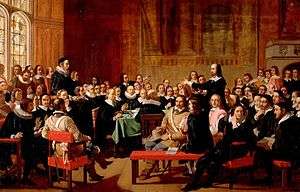
The Puritan movement in England was riven over decades by emigration and inconsistent interpretations of Scripture, as well as some political differences that surfaced at that time. The Fifth Monarchy Men, a radical millenarian wing of Puritanism, aided by strident, popular clergy like Vavasor Powell, agitated from the right wing of the movement, even as sectarian groups like the Ranters, Levellers, and Quakers pulled from the left.[17][18] The fragmentation created a collapse of the centre and, ultimately, sealed a political failure, while depositing an enduring spiritual legacy that would remain and grow in English-speaking Christianity.[19]
The Westminster Assembly was called in 1643, assembling clergy of the Church of England. The Assembly was able to agree to the Westminster Confession of Faith doctrinally, a consistent Reformed theological position. The Directory of Public Worship was made official in 1645, and the larger framework (now called the Westminster Standards) was adopted by the Church of Scotland. In England, the Standards were contested by Independents up to 1660.[20]
The Westminster Divines, on the other hand, were divided over questions of church polity and split into factions supporting a reformed episcopacy, presbyterianism, congregationalism, and Erastianism. The membership of the Assembly was heavily weighted towards the Presbyterians, but Oliver Cromwell was a Puritan and an independent Congregationalist separatist who imposed his doctrines upon them. The Church of England of the Interregnum (1649–60) was run along Presbyterian lines but never became a national Presbyterian church, such as existed in Scotland, and England was not the theocratic state which leading Puritans had called for as "godly rule".[21]
Great Ejection and Dissenters
At the time of the English Restoration in 1660, the Savoy Conference was called to determine a new religious settlement for England and Wales. Under the Act of Uniformity 1662, the Church of England was restored to its pre-Civil War constitution with only minor changes, and the Puritans found themselves sidelined. A traditional estimate of historian Calamy is that around 2,400 Puritan clergy left the Church in the "Great Ejection" of 1662.[22] At this point, the term "Dissenter" came to include "Puritan", but more accurately described those (clergy or lay) who "dissented" from the 1662 Book of Common Prayer.[23]
The Dissenters divided themselves from all Christians in the Church of England and established their own separatist congregations in the 1660s and 1670s. An estimated 1,800 of the ejected clergy continued in some fashion as ministers of religion, according to Richard Baxter.[22] The government initially attempted to suppress these schismatic organisations by using the Clarendon Code. There followed a period in which schemes of "comprehension" were proposed, under which Presbyterians could be brought back into the Church of England, but nothing resulted from them. The Whigs opposed the court religious policies and argued that the Dissenters should be allowed to worship separately from the established Church, and this position ultimately prevailed when the Toleration Act was passed in the wake of the Glorious Revolution in 1689. This permitted the licensing of Dissenting ministers and the building of chapels. The term "Nonconformist" generally replaced the term "Dissenter" from the middle of the 18th century.
Puritans in North America
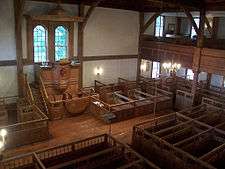
Some Puritans left for New England, particularly in the years after 1630, supporting the founding of the Massachusetts Bay Colony and other settlements among the northern colonies. The large-scale Puritan immigration to New England ceased by 1641, with around 21,000 having moved across the Atlantic. This English-speaking population in America did not all consist of original colonists, since many returned to England shortly after arriving on the continent, but it produced more than 16 million descendants.[24][25] This so-called "Great Migration" is not so named because of sheer numbers, which were much less than the number of English citizens who immigrated to Virginia and the Caribbean during this time.[26] The rapid growth of the New England colonies (around 700,000 by 1790) was almost entirely due to the high birth rate and lower death rate per year.[27]
Puritan hegemony lasted for at least a century. That century can be broken down into three parts: the generation of John Cotton and Richard Mather, 1630–61 from the founding to the Restoration, years of virtual independence and nearly autonomous development; the generation of Increase Mather, 1662–89 from the Restoration and the Halfway Covenant to the Glorious Revolution, years of struggle with the British crown; and the generation of Cotton Mather, 1689–1728 from the overthrow of Edmund Andros (in which Cotton Mather played a part) and the new charter, mediated by Increase Mather, to the death of Cotton Mather.[28]
Beliefs
Calvinism
| Part of a series on |
| Calvinism |
|---|
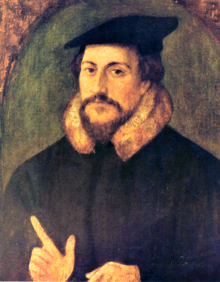 |
|
Background |
|
Documents |
|
Peoples |
|
|
Puritanism broadly refers to a diverse religious reform movement in Britain committed to the continental Reformed tradition.[29] While Puritans did not agree on all doctrinal points, most shared similar views on the nature of God, human sinfulness, and the relationship between God and mankind. They believed that all of their beliefs should be based on the Bible, which they considered to be divinely inspired.[30]
The concept of covenant was extremely important to Puritans, and covenant theology was central to their beliefs. With roots in the writings of Reformed theologians John Calvin and Heinrich Bullinger, covenant theology was further developed by Puritan theologians Dudley Fenner, William Perkins, John Preston, Richard Sibbes, William Ames and, most fully by Ames's Dutch student, Johannes Cocceius.[31] Covenant theology asserts that when God created Adam and Eve he promised them eternal life in return for perfect obedience; this promise was termed the covenant of works. After the fall of man, human nature was corrupted by original sin and unable to fulfill the covenant of works, since each person inevitably violated God's law as expressed in the Ten Commandments. As sinners, every person deserved damnation.[32]
Puritans shared with other Calvinists a belief in double predestination, that some people (the elect) were destined by God to receive grace and salvation while others were destined for Hell.[33] No one, however, could merit salvation. According to covenant theology, Christ's sacrifice on the cross made possible the covenant of grace, by which those selected by God could be saved. Puritans believed in unconditional election and irresistible grace—God's grace was given freely without condition to the elect and could not be refused.[34]
Conversion
Covenant theology made individual salvation deeply personal. It held that God's predestination was not "impersonal and mechanical" but was a "covenant of grace" that one entered into by faith. Therefore, being a Christian could never be reduced to simple "intellectual acknowledgment" of the truth of Christianity. Puritans agreed "that the effectual call of each elect saint of God would always come as an individuated personal encounter with God's promises".[35]
The process by which the elect are brought from spiritual death to spiritual life (regeneration) was described as conversion.[34] Early on, Puritans did not consider a specific conversion experience normative or necessary, but many gained assurance of salvation from such experiences. Over time, however, Puritan theologians developed a framework for authentic religious experience based on their own experiences as well as those of their parishioners. Eventually, Puritans came to regard a specific conversion experience as an essential mark of one's election.[36]
The Puritan conversion experience was commonly described as occurring in discrete phases. It began with a preparatory phase designed to produce contrition for sin through introspection, Bible study and listening to preaching. This was followed by humiliation, when the sinner realized that he or she was helpless to break free from sin and that their good works could never earn forgiveness.[34] It was after reaching this point—the realization that salvation was possible only because of divine mercy—that the person would experience justification, when the righteousness of Christ is imputed to the elect and their minds and hearts are regenerated. For some Puritans, this was a dramatic experience and they referred to it as being born again.[37]
Confirming that such a conversion had actually happened often required prolonged and continual introspection. Historian Perry Miller wrote that the Puritans "liberated men from the treadmill of indulgences and penances, but cast them on the iron couch of introspection".[38] It was expected that conversion would be followed by sanctification—"the progressive growth in the saint’s ability to better perceive and seek God’s will, and thus to lead a holy life".[37] Some Puritans attempted to find assurance of their faith by keeping detailed records of their behavior and looking for the evidence of salvation in their lives. Puritan clergy wrote many spiritual guides to help their parishioners pursue personal piety and sanctification. These included Arthur Dent's The Plain Man’s Pathway to Heaven (1601), Richard Rogers's Seven Treatises (1603), Henry Scudder's Christian’s Daily Walk (1627) and Richard Sibbes's The Bruised Reed and Smoking Flax (1630).[39]
Too much emphasis on one's good works could be criticized for being too close to Arminianism, and too much emphasis on subjective religious experience could be criticized as Antinomianism. Many Puritans relied on both personal religious experience and self-examination to assess their spiritual condition.[39]
Puritanism's experiential piety would be inherited by the evangelical Protestants of the 18th century.[38] While evangelical views on conversion were heavily influenced by Puritan theology, the Puritans believed that assurance of one's salvation was "rare, late and the fruit of struggle in the experience of believers", whereas evangelicals believed that assurance was normative for all the truly converted.[40]
Worship and sacraments
The sermon was central to Puritan public worship. The sermon was not only a means of religious education; Puritans believed it was the most common way that God prepared a sinner's heart for conversion.[41] Puritans eliminated choral music and musical instruments in their religious services because these were associated with Roman Catholicism; however, settings of the Psalms were considered appropriate.[42] Church organs were commonly damaged or destroyed in the Civil War period, such as when an axe was taken to the organ of Worcester Cathedral in 1642.[43] Puritans taught that there were two sacraments: baptism and the Lord's Supper. They rejected confirmation as unnecessary.[44]
Puritans unanimously rejected the Roman Catholic doctrine of baptismal regeneration, but they disagreed among themselves on the effects of baptism and its relationship to regeneration. Most Puritans practiced infant baptism, but a minority held credobaptist beliefs. Those who baptized infants understood it through the lens of covenant theology, believing that baptism had replaced circumcision as a sign of the covenant and marked a child's admission into the visible church. In "A Discourse on the Nature of Regeneration", Stephen Charnock distinguished regeneration from "external baptism" writing that baptism "confers not grace" but rather is a means of conveying the grace of regeneration only "when the [Holy] Spirit is pleased to operate with it". Therefore, one cannot assume that baptism produces regeneration. The Westminster Confession states that the grace of baptism is only effective for those who are among the elect; however, its effects are not tied to the moment of baptism but lies dormant until one experiences conversion later in life.[45]
Puritans rejected both Roman Catholic (transubstantiation) and Lutheran (sacramental union) teachings that Christ is physically present in the bread and wine of the Lord's Supper. Instead, Puritans embraced the Reformed doctrine of real spiritual presence, believing that in the Lord's Supper the faithful receive Christ spiritually. In agreement with Thomas Cranmer, the Puritans stressed "that Christ comes down to us in the sacrament by His Word and Spirit, offering Himself as our spiritual food and drink".[46]
Ecclesiology
While the Puritans were united in their goal of furthering the English Reformation, they were always divided over issues of ecclesiology and church polity, specifically questions relating to the manner of organizing congregations, how individual congregations should relate with one another and whether established national churches were scriptural.[36] On these questions, Puritans divided between supporters of episcopal polity, presbyterian polity and congregational polity.
The episcopalians (known as the prelatical party) were conservatives who supported retaining bishops if those leaders supported reform and agreed to share power with local churches.[47] They also supported the idea of having a Book of Common Prayer, but they were against demanding strict conformity or having too much ceremony. In addition, these Puritans called for a renewal of preaching, pastoral care and Christian discipline within the Church of England.[36]
Like the episcopalians, the presbyterians agreed that there should be a national church but one structured on the model of the Church of Scotland.[47] They wanted to replace bishops with a system of elective and representative governing bodies of clergy and laity (local sessions, presbyteries, synods, and ultimately a national general assembly).[36] During the Interregnum, the presbyterians had limited success at reorganizing the Church of England. The Westminster Assembly proposed the creation of a presbyterian system, but the Long Parliament left implementation to local authorities. As a result, the Church of England never developed a complete presbyterian hierarchy.[48]
Congregationalists or Independents believed in the autonomy of the local church, which ideally would be a congregation of "visible saints" (meaning those who had experienced conversion).[49] Members would be required to abide by a church covenant, in which they "pledged to join in the proper worship of God and to nourish each other in the search for further religious truth".[47] Such churches were regarded as complete within themselves, with full authority to determine their own membership, administer their own discipline and ordain their own ministers. Furthermore, the sacraments would only be administered to those in the church covenant.[50]
Most congregational Puritans remained within the Church of England, hoping to reform it according to their own views. The New England Congregationalists were also adamant that they were not separating from the Church of England. However, some Puritans equated the Church of England with the Roman Catholic Church, and therefore considered it no Christian church at all. These groups, such as the Brownists, would split from the established church and become known as Separatists. Other Separatists embraced more radical positions on separation of church and state and believer's baptism, becoming early Baptists.[50]
Family life
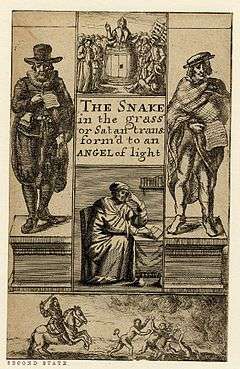
Based on Biblical portrayals of Adam and Eve, Puritans believed that marriage was rooted in procreation, love, and, most importantly, salvation.[51] Husbands were the spiritual heads of the household, while women were to demonstrate religious piety and obedience under male authority.[52] Furthermore, marriage represented not only the relationship between husband and wife, but also the relationship between spouses and God. Puritan husbands commanded authority through family direction and prayer. The female relationship to her husband and to God was marked by submissiveness and humility.[53]
Thomas Gataker describes Puritan marriage as:
... together for a time as copartners in grace here, [that] they may reigne together forever as coheires in glory hereafter.[54]
The paradox created by female inferiority in the public sphere and the spiritual equality of men and women in marriage, then, gave way to the informal authority of women concerning matters of the home and childrearing.[55] With the consent of their husbands, wives made important decisions concerning the labour of their children, property, and the management of inns and taverns owned by their husbands.[56] Pious Puritan mothers laboured for their children's righteousness and salvation, connecting women directly to matters of religion and morality.[57] In her poem titled "In Reference to her Children", poet Anne Bradstreet reflects on her role as a mother:
I had eight birds hatched in one nest; Four cocks there were, and hens the rest. I nursed them up with pain and care, Nor cost nor labour I did spare.
Bradstreet alludes to the temporality of motherhood by comparing her children to a flock of birds on the precipice of leaving home. While Puritans praised the obedience of young children, they also believed that, by separating children from their mothers at adolescence, children could better sustain a superior relationship with God.[58] A child could only be redeemed through religious education and obedience. Girls carried the additional burden of Eve's corruption and were catechised separately from boys at adolescence. Boys' education prepared them for vocations and leadership roles, while girls were educated for domestic and religious purposes. The pinnacle of achievement for children in Puritan society, however, occurred with the conversion process.[57]
Puritans viewed the relationship between master and servant similarly to that of parent and child. Just as parents were expected to uphold Puritan religious values in the home, masters assumed the parental responsibility of housing and educating young servants. Older servants also dwelt with masters and were cared for in the event of illness or injury. African-American and Indian servants were likely excluded from such benefits.[59]
Demonology and witch hunts
Like most Christians in the early modern period, Puritans believed in the active existence of the devil and demons as evil forces that could possess and cause harm to men and women. There was also widespread belief in witchcraft and witches—persons in league with the devil. "Unexplained phenomena such as the death of livestock, human disease, and hideous fits suffered by young and old" might all be blamed on the agency of the devil or a witch.[60]
Puritan pastors undertook exorcisms for demonic possession in some high-profile cases. Exorcist John Darrell was supported by Arthur Hildersham in the case of Thomas Darling.[61] Samuel Harsnett, a skeptic on witchcraft and possession, attacked Darrell. However, Harsnett was in the minority, and many clergy, not only Puritans, believed in witchcraft and possession.[62]
In the 16th and 17th centuries, thousands of people throughout Europe were accused of being witches and executed. In England and America, Puritans engaged in witch hunts as well. In the 1640s, Matthew Hopkins, the self-proclaimed "Witchfinder General", was responsible for accusing over two hundred people of witchcraft, mainly in East Anglia. In New England, few people were accused and convicted of witchcraft before 1692; there were at most sixteen convictions.[63]
The Salem witch trials of 1692 had a lasting impact on the historical reputation of New England Puritans. Though this witch hunt occurred after Puritans lost political control of the Massachusetts colony, Puritans instigated the judicial proceedings against the accused and comprised the members of the court that convicted and sentenced the accused. By the time Governor William Phips ended the trials, fourteen women and five men had been hanged as witches.[64]
Millennialism
Puritan millennialism has been placed in the broader context of European Reformed beliefs about the millennium and interpretation of biblical prophecy, for which representative figures of the period were Johannes Piscator, Thomas Brightman, Joseph Mede, Johannes Heinrich Alsted, and John Amos Comenius.[65] Like most English Protestants of the time, Puritans based their eschatological views on an historicist interpretation of the Book of Revelation and the Book of Daniel. Protestant theologians identified the sequential phases the world must pass through before the Last Judgment could occur and tended to place their own time period near the end. It was expected that tribulation and persecution would increase but eventually the church's enemies—the Antichrist (identified with the Roman Catholic Church) and the Ottoman Empire—would be defeated.[66] Based on Revelation 20, it was believed that a thousand year period (the millennium) would occur, during which the saints would rule with Christ on earth.[67]
In contrast to other Protestants who tended to view eschatology as an explanation for "God's remote plans for the world and man", Puritans understood it to describe "the cosmic environment in which the regenerate soldier of Christ was now to do battle against the power of sin".[68] On a personal level, eschatology was related to sanctification, assurance of salvation, and the conversion experience. On a larger level, eschatology was the lens through which events such as the English Civil War and the Thirty Years' War were interpreted. There was also an optimistic aspect to Puritan millennianism; Puritans anticipated a future worldwide religious revival before the Second Coming of Christ.[69][67] Another departure from other Protestants was the widespread belief among Puritans that the conversion of the Jews to Christianity was an important sign of the apocalypse.[70]
David Brady describes a "lull before the storm" in the early 17th century, in which "reasonably restrained and systematic" Protestant exegesis of the Book of Revelation was seen with Brightman, Mede, and Hugh Broughton, after which "apocalyptic literature became too easily debased" as it became more populist and less scholarly.[71] William Lamont argues that, within the church, the Elizabethan millennial beliefs of John Foxe became sidelined, with Puritans adopting instead the "centrifugal" doctrines of Thomas Brightman, while the Laudians replaced the "centripetal" attitude of Foxe to the "Christian Emperor" by the national and episcopal Church closer to home, with its royal head, as leading the Protestant world iure divino (by divine right).[72] Viggo Norskov Olsen writes that Mede "broke fully away from the Augustinian-Foxian tradition, and is the link between Brightman and the premillennialism of the 17th century".[73] The dam broke in 1641 when the traditional retrospective reverence for Thomas Cranmer and other martyred bishops in the Acts and Monuments was displaced by forward-looking attitudes to prophecy among radical Puritans.[72]
Cultural consequences
Some strong religious beliefs common to Puritans had direct impacts on culture. Education was essential to every person, male and female, so that they could read the Bible for themselves. However, the Puritans' emphasis on individual spiritual independence was not always compatible with the community cohesion that was also a strong ideal.[74] Anne Hutchinson (1591 – 1643), the well educated daughter of a teacher, argued with the established theological orthodoxy, and was forced to leave the colony with her followers.[75]
Education
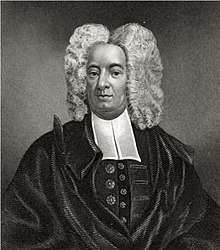
At a time when the literacy rate in England was less than 30 percent, the Puritan leaders of colonial New England believed children should be educated for both religious and civil reasons, and they worked to achieve universal literacy.[76] In 1642, Massachusetts required heads of households to teach their wives, children and servants basic reading and writing so that they could read the Bible and understand colonial laws. In 1647, the government required all towns with 50 or more households to hire a teacher and towns of 100 or more households to hire a grammar school instructor to prepare promising boys for college. Boys interested in the ministry were often sent to colleges such as Harvard (founded in 1636) or Yale (founded in 1707).[77] Aspiring lawyers or doctors apprenticed to a local practitioner, or in rare cases were sent to England or Scotland.[78]
Puritan scientists
The Merton Thesis is an argument about the nature of early experimental science proposed by Robert K. Merton. Similar to Max Weber's famous claim on the link between the Protestant work ethic and the capitalist economy, Merton argued for a similar positive correlation between the rise of English Puritanism, as well as German Pietism, and early experimental science.[79] As an example, seven of 10 nucleus members of the Royal Society were Puritans. In the year 1663, 62 percent of the members of the Royal Society were similarly identified.[80] The Merton Thesis has resulted in continuous debates.[81]
Behavioral regulations
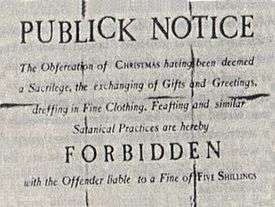
Puritans in both England and New England believed that the state should protect and promote true religion and that religion should influence politics and social life.[82][83] Certain holidays were outlawed when Puritans came to power. In 1647, Parliament outlawed the celebration of Christmas, Easter and Whitsuntide.[84] Christmas was outlawed in Boston from 1659.[85] Puritans objected to Christmas because the festivities surrounding the holiday were seen as impious. (English jails were usually filled with drunken revelers and brawlers.)[86]
Puritans were opposed to Sunday sport or recreation because these distracted from religious observance of the Sabbath.[83] Other forms of leisure and entertainment were completely forbidden on moral grounds. For example, Puritans were universally opposed to blood sports such as bearbaiting and cockfighting because they involved unnecessary injury to God's creatures. For similar reasons, they also opposed boxing.[41] These sports were illegal in England during Puritan rule.[87]
Card playing and gambling were banned in England and the colonies (but card playing by itself was generally considered acceptable), as was mixed dancing involving men and women because it was thought to lead to fornication.[82][88] Folk dance that did not involve close contact between men and women was considered appropriate.[89] In New England, the first dancing school did not open until the end of the 17th century.[83]
Puritans condemned the sexualization of the theatre and its associations with depravity and prostitution—London's theatres were located on the south side of the Thames, which was a center of prostitution. A major Puritan attack on the theatre was William Prynne's book Histriomastix. Puritan authorities shut down English theatres in the 1640s and 1650s, and none were allowed to open in Puritan-controlled colonies.[90][91]
Puritans were not opposed to drinking alcohol in moderation.[92] However, alehouses were closely regulated by Puritan-controlled governments in both England and America.[83] Early New England laws banning the sale of alcohol to Native Americans were criticised because it was "not fit to deprive Indians of any lawfull comfort aloweth to all men by the use of wine". Laws banned the practice of individuals toasting each other, with the explanation that it led to wasting God's gift of beer and wine, as well as being carnal.
Bounds were not set on enjoying sexuality within the bounds of marriage, as a gift from God.[93] Spouses were disciplined if they did not perform their sexual marital duties, in accordance with 1 Corinthians 7 and other biblical passages. Women and men were equally expected to fulfill marital responsibilities.[94] Women and men could file for divorce based on this issue alone. In Massachusetts colony, which had some of the most liberal colonial divorce laws, one out of every six divorce petitions was filed on the basis on male impotence.[95] Puritans publicly punished drunkenness and sexual relations outside marriage.[82] Couples who had sex during their engagement were fined and publicly humiliated.[82] Men, and a handful of women, who engaged in homosexual behavior, were seen as especially sinful, with some executed.[82]
Opposition to other religious views
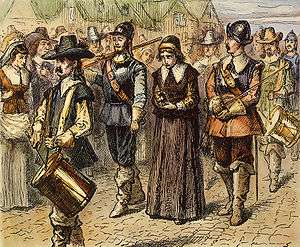
The Puritans exhibited intolerance to other religious views, including Quaker, Anglican and Baptist theologies. The Puritans of the Massachusetts Bay Colony were the most active of the New England persecutors of Quakers, and the persecuting spirit was shared by the Plymouth Colony and the colonies along the Connecticut river.[96]
In 1660, one of the most notable victims of the religious intolerance was English Quaker Mary Dyer, who was hanged in Boston for repeatedly defying a Puritan law banning Quakers from the colony.[96] She was one of the four executed Quakers known as the Boston martyrs. The hanging of Dyer on Boston Common marked the beginning of the end of the Puritan theocracy.[97] In 1661, King Charles II explicitly forbade Massachusetts from executing anyone for professing Quakerism.[97] In 1684, England revoked the Massachusetts charter, sent over a royal governor to enforce English laws in 1686 and, in 1689, passed a broad Toleration Act.[97]
The first two of the four Boston martyrs were executed by the Puritans on 27 October 1659, and in memory of this, 27 October is now International Religious Freedom Day to recognise the importance of freedom of religion.[98] Anti-Catholic sentiment appeared in New England with the first Pilgrim and Puritan settlers.[99] In 1647, Massachusetts passed a law prohibiting any Jesuit Roman Catholic priests from entering territory under Puritan jurisdiction.[100] Any suspected person who could not clear himself was to be banished from the colony; a second offense carried a death penalty.[101]
Historiography
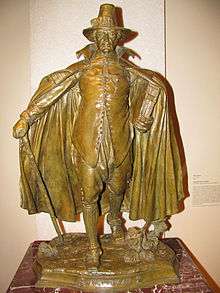
The literature on Puritans, particularly biographical literature on individual Puritan ministers, was already voluminous in the 17th century and, indeed, the interests of Puritans in the narratives of early life and conversions made the recording of the internal lives important to them. The historical literature on Puritans is, however, quite problematic and subject to controversies over interpretation. The early writings are those of the defeated, excluded and victims. The great interest of authors of the 19th century in Puritan figures was routinely accused in the 20th century of consisting of anachronism and the reading back of contemporary concerns.
A debate continues on the definition of "Puritanism".[102] English historian Patrick Collinson believes that "Puritanism had no content beyond what was attributed to it by its opponents."[103] The analysis of "mainstream Puritanism" in terms of the evolution from it of Separatist and antinomian groups that did not flourish, and others that continue to this day, such as Baptists and Quakers, can suffer in this way. The national context (England and Wales, as well as the kingdoms of Scotland and Ireland) frames the definition of Puritans, but was not a self-identification for those Protestants who saw the progress of the Thirty Years' War from 1620 as directly bearing on their denomination, and as a continuation of the religious wars of the previous century, carried on by the English Civil Wars. English historian Christopher Hill, who has contributed to analyses of Puritan concerns that are more respected than accepted, writes of the 1630s, old church lands, and the accusations that William Laud was a crypto-Catholic:
To the heightened Puritan imagination it seemed that, all over Europe, the lamps were going out: the Counter-Reformation was winning back property for the church as well as souls: and Charles I and his government, if not allied to the forces of the Counter-Reformation, at least appeared to have set themselves identical economic and political objectives.[104]
Puritans were politically important in England, but it is debated whether the movement was in any way a party with policies and leaders before the early 1640s. While Puritanism in New England was important culturally for a group of colonial pioneers in America, there have been many studies trying to pin down exactly what the identifiable cultural component was. Fundamentally, historians remain dissatisfied with the grouping as "Puritan" as a working concept for historical explanation. The conception of a Protestant work ethic, identified more closely with Calvinist or Puritan principles, has been criticised at its root, mainly as a post hoc ergo propter hoc fallacy aligning economic success with a narrow religious scheme.
Notable Puritans
- Peter Bulkley was an influential Puritan minister and founder of Concord.
- John Bunyan, famous for The Pilgrim's Progress
- William Bradford was Plymouth Colony's Governor.
- Anne Bradstreet was the first female to have her works published in the British North American colonies.
- Oliver Cromwell was an English military and political leader and eventually became Lord Protector of the Commonwealth of England, Scotland and Ireland. He was a very religious man and was considered an independent Puritan.
- John Endecott was the first governor of the Massachusetts Bay Colony and an important military leader.
- Jonathan Edwards, evangelical preacher who sparked the First Great Awakening
- Anne Hutchinson was a Puritan woman noted for speaking freely about her religious views, which resulted in her banishment from Massachusetts Bay Colony.
- James Noyes was an influential Puritan minister, teacher and founder of Newbury.
- Thomas Parker was an influential Puritan minister, teacher and founder of Newbury.
- John Winthrop is noted for his sermon "A Model of Christian Charity" and as a leading figure in founding the Massachusetts Bay Colony.
- Robert Woodford was an English lawyer, largely based at Northampton and London. His diary for the period 1637-1641 records in detail the outlook of an educated Puritan.
See also
Footnotes
- ↑ Julie Spraggon (2003). "Puritan Iconoclasm During the English Civil War". p. 98. Boydell Press
- ↑ Cliffe, Trevor (11 September 2002). Puritan Gentry Besieged 1650–1700. Routledge. p. 195. ISBN 9781134918157.
- ↑ Miller, Randall M. (30 December 2008). The Greenwood Encyclopedia of Daily Life in America. ABC-CLIO. p. 296. ISBN 9780313065361.
Congregationalists were theologically descended directly from the Puritans of England and consequently enjoyed pride of place as one of the oldest, most numerous, and most significant religious groups in the colonies.
- ↑ Archpriest John W. Morris (2011). "The Historic Church: An Orthodox View of Christian History". p. 438. Author House
- ↑ Puritans and Puritanism in Europe and America. ABC-CLIO. 2006. p. 534. ISBN 9781576076781.
- ↑ Spurr, John (1998). English Puritanism, 1603–1689. Social History in Perspective. Palgrave MacMillan. p. 3. ISBN 978-0-333-60189-1.
- ↑ "Puritanism (Lat. purit... – Online Information article about Puritanism (Lat. purit". Encyclopedia.jrank.org. Archived from the original on 9 December 2010. Retrieved 21 August 2010.
- ↑ Spurr 1998, p. 4.
- ↑ C. Jack Trickler (4 February 2010). A Layman's Guide To: Why Are There So Many Christian Denominations?. AuthorHouse. p. 146. ISBN 978-1-4490-4578-4. Archived from the original on 18 July 2013. Retrieved 4 November 2012.
- ↑ Geoffrey F. Nuttall (15 July 1992). The Holy Spirit in Puritan Faith and Experience. University of Chicago Press. p. 9. ISBN 978-0-226-60941-6. Archived from the original on 27 June 2014. Retrieved 4 November 2012.
- ↑ Spurr 1998, p. 7.
- ↑ H. L. Mencken, "Puritanism: The haunting fear that someone, somewhere, may be happy", from A Book of Burlesques (1916), being a classic rendering.
- ↑ Gay, Peter (1984), The Bourgeois Experience: The Tender Passion, W. W. Norton & Company, p. 49, ISBN 9780393319033, archived from the original on 2 January 2017
- ↑ Coffin, Charles (1987), The Story of Liberty: So You Will Comprehend What Liberty Has Cost, and What It Is Worth, Maranatha Publications, ISBN 093855820X
- ↑ Neil (1844), p. 246 Archived 4 May 2016 at the Wayback Machine.
- ↑ John Spurr, English Puritanism, 1603–1689 (1998), Chapter 5.
- ↑ Milton, Michael A. (1997). The Application of the Faith of the Westminster Assembly in the Ministry of the Welsh Puritan, Vavasor Powell (1617–1670) (Ph.D.). University of Wales.
- ↑ Hill, Christopher (1972). The World Turned Upside Down; Radical Ideas During the English Revolution (Print). Viking.
- ↑ Kelly, Douglas F. (1992). The Emergence of Liberty in the Modern World: The Influence of Calvin on Five Governments from the 16th Through 18th Centuries (Print). P&R.
- ↑ Robert Benedetto; Donald K. McKim (2010). Historical Dictionary of the Reformed Churches. Scarecrow Press. pp. 521–2. ISBN 978-0-8108-5807-7. Archived from the original on 18 July 2013. Retrieved 4 November 2012.
- ↑ William M. Lamont, Godly Rule: Politics and Religion 1603–60 (1969).
- 1 2

- ↑ Leighton, Denys (2004). The Greenian Moment: T.H. Green, Religion and Political Argument in Victorian Britain. Imprint Academic. ISBN 9780907845546.
- ↑ David Hackett Fischer, Albion's Seed: Four British Folkways in America (1989) ISBN 0-19-506905-6
- ↑ "The Puritans: A Sourcebook of Their Writings Archived 16 January 2010 at the Wayback Machine.". Perry Miller and Thomas H. Johnson.
- ↑ "Leaving England: The Social Background of Indentured Servants in the Seventeenth Century Archived 6 January 2009 at the Wayback Machine.", The Colonial Williamsburg Foundation.
- ↑ Francis J. Bremer, The Puritan Experiment: New England Society from Bradford to Edwards (1995).
- ↑ Carpenter, John B. (2003) "New England's Puritan Century: Three Generations of Continuity in the City upon a Hill," Fides Et Historia 30:1, p. 41.
- ↑ Ahlstrom, Sydney E. (2004) [1972]. A Religious History of the American People (2nd ed.). Yale University Press. p. 125. ISBN 0-385-11164-9.
- ↑ Bremer, Francis J. (2009). Puritanism: A Very Short Introduction. Oxford University Press. p. 35. ISBN 9780199740871.
- ↑ Ahlstrom 2004, pp. 130–131.
- ↑ Bremer 2009, pp. 37–38.
- ↑ Bremer 2009, p. 40.
- 1 2 3 Bremer 2009, p. 42.
- ↑ Ahlstrom 2004, p. 131.
- 1 2 3 4 Ahlstrom 2004, p. 132.
- 1 2 Bremer 2009, p. 43.
- 1 2 Ahlstrom 2004, p. 128.
- 1 2 Bremer 2009, p. 44.
- ↑ Bebbington, David W (1993), Evangelicalism in Modern Britain: A History from the 1730s to the 1980s, London: Routledge, p. 43
- 1 2 Bremer 2009, p. 59.
- ↑ Bremer 2009, p. 65.
- ↑ "Worcester Cathedral welcomes you to their Website". Worcestercathedral.co.uk. 20 February 2010. Archived from the original on 23 August 2010. Retrieved 21 August 2010.
- ↑ White, James F. (1999). The Sacraments in Protestant Practice and Faith. Abingdon Press. p. 49. ISBN 0-687-03402-7.
- ↑ Beeke, Joel R.; Jones, Mark (2012). A Puritan Theology: Doctrine for Life (Amazon Kindle ed.). "Regeneration and Baptism", location 18043–18056: Reformation Heritage Books. ISBN 978-1-60178-166-6.
- ↑ Beeke & Jones 2012, "The True Meaning of the Lord's Supper", Amazon Kindle location 28097–28107.
- 1 2 3 Bremer 2009, p. 69.
- ↑ Bremer 2009, p. 72.
- ↑ Ahlstrom 2004, pp. 132–133.
- 1 2 Ahlstrom 2004, p. 133.
- ↑ Porterfield, Amanda (1992). Female Piety in Puritan New England the Emergence of Religious Humanism. New York: Oxford University Press. p. 82.
- ↑ Norton, Mary Beth (2011). Separated by Their Sex: Women in Public and Private in the Colonial Atlantic World. Ithaca: Cornell University Press. p. 91.
- ↑ Porterfield, Amanda (1992). Female Piety in Puritan New England the Emergence of Religious Humanism. New York: Oxford University Press. p. 81.
- ↑ Johnson, James Turner (1970). A Society Ordained by God. Nashville: Abingdon Press. p. 93.
- ↑ Ulrich, Laurel Thatcher (1976). "Vertuous Women Found: New England Ministerial Literature, 1668–1735". American Quarterly. 28.1: 37. doi:10.2307/2712475.
- ↑ Demos, John (1970). A Little Commonwealth; Family Life in Plymouth Colony. New York: Oxford University Press.
- 1 2 Saxton, Martha (2003). Being Good: Women's Moral Values in Early America. New York: Hill and Wang. p. 82.
- ↑ Ulrich, Laurel Thatcher (1976). "Vertuous Women Found: New England Ministerial Literature 1668–1735". American Quarterly. 28.1: 35. doi:10.2307/2712475.
- ↑ Demos, John (1970). A Little Commonwealth; Family Life in Plymouth Colony. New York: Oxford University Press. pp. 107–117.
- ↑ Bremer 2009, p. 30.
- ↑ Francis J. Bremer, Tom Webster, Puritans and Puritanism in Europe and America: A Comprehensive Encyclopedia (2006), p. 584.
- ↑

- ↑ Bremer 2009, pp. 31–32.
- ↑ Bremer 2009, pp. 30–32.
- ↑ Howard Hotson, Paradise Postponed: Johann Heinrich Alsted and the Birth of Calvinist Millenarianism (2001), p. 173.
- ↑ Maclear, J. F. (April 1975). "New England and the Fifth Monarchy: The Quest for the Millennium in Early American Puritanism". The William and Mary Quarterly. Omohundro Institute of Early American History and Culture. 32 (2): 225–226. JSTOR 1921563.
- 1 2 Bremer 2009, p. 76.
- ↑ Maclear 1975, p. 226.
- ↑ Maclear 1975, p. 227.
- ↑ Maclear 1975, p. 229.
- ↑ David Brady, The Contribution of British Writers Between 1560 and 1830 to the Interpretation of Revelation 13.16–18 (1983), p. 58.
- 1 2 William M. Lamont, Godly Rule: Politics and Religion 1603–60 (1969), p. 25, 36, 59, 67, 78.
- ↑ Viggo Norskov Olsen, John Foxe and the Elizabethan Church (1973), p. 84.
- ↑ Joseph Watras, "Education and evangelism in the English colonies." American Educational History Journal 35.1/2 (2008): 205-219.
- ↑ Francis J. Bremer, ed., Anne Hutchinson: Troubler of the Puritan Zion (1981).
- ↑ James Axtell, The School upon a Hill: Education and Society in Colonial New England (1976)
- ↑ Bremer 2009, pp. 81–82.
- ↑ Peter James Marshall (2005). The Making and Unmaking of Empires: Britain, India, and America C.1750-1783. p. 30.
- ↑ Sztompka, 2003
- ↑ Harrison, Peter (26 July 2001). The Bible, Protestantism, and the Rise of Natural Science. Cambridge University Press. ISBN 9780521000963. Archived from the original on 2 January 2017.
- ↑ Cohen, 1990
- 1 2 3 4 5 Norton, Mary Beth (2008). People and a Nation: A History of the United States, Volume 1: To 1877, Brief. P. 49. Cengage Learning
- 1 2 3 4 Bremer 2009, p. 79.
- ↑ Spencer, Ivor Debenham (December 1935). "Christmas, the Upstart". The New England Quarterly. The New England Quarterly, Inc. 8 (4): 499. JSTOR 360356.
- ↑ Barnett, James Harwood (1984). The American Christmas: A Study in National Culture. Ayer Publishing. p. 3. ISBN 0-405-07671-1. Archived from the original on 20 May 2016.
- ↑ Spencer 1935, p. 498.
- ↑ Bremer 2009, p. 80.
- ↑ Miller, Perry; Johnson, Thomas H. (2014). The Puritans: A Sourcebook of Their Writings. Courier Corporation,. p. 394.
- ↑ Bremer 2009, p. 60.
- ↑ N. H. Keeble, The Literary Culture of Nonconformity in Later Seventeenth-Century England (1987), p. 153.
- ↑ Bremer 2009, p. 58.
- ↑ West (2003) pp. 68ff
- ↑ Lewis (1969), pp. 116–117. "On many questions and specially in view of the marriage bed, the Puritans were the indulgent party, ... they were much more Chestertonian than their adversaries [the Roman Catholics]. The idea that a Puritan was a repressed and repressive person would have astonished Sir Thomas More and Luther about equally."
- ↑ Foster, Thomas (October 1999). "Deficient Husbands: Manhood, Sexual Incapacity, and Male Marital Sexuality in Seventeenth-Century New England". The William and Mary Quarterly. 56 (4): 724. doi:10.2307/2674233.
- ↑ Foster, Thomas (October 1999). "Deficient Husbands: Manhood, Sexual Incapacity, and Male Marital Sexuality in Seventeenth-Century New England". The William and Mary Quarterly. 56 (4): 726–727. doi:10.2307/2674233.
- 1 2 Rogers, Horatio, 2009. Mary Dyer of Rhode Island: The Quaker Martyr That Was Hanged on Boston Archived 15 January 2016 at the Wayback Machine. pp.1–2. BiblioBazaar, LLC
- 1 2 3 "Puritans and Puritanism in Europe and America". ABC-CLIO. 1 January 2006. Archived from the original on 26 January 2018 – via Google Books.
- ↑ Margery Post Abbott (2011). Historical Dictionary of the Friends (Quakers). Scarecrow Press. pp. 102. ISBN 978-0-8108-7088-8. Archived from the original on 10 May 2016.
- ↑ "America's dark and not-very-distant history of hating Catholics". The Guardian. 25 February 2016. Archived from the original on 30 December 2016.
- ↑ Pat, Perrin (1 January 1970). Crime and Punishment: The Colonial Period to the New Frontier. Discovery Enterprises. p. 24.
- ↑ Mahoney, Kathleen A. (10 September 2003). Catholic Higher Education in Protestant America: The Jesuits and Harvard in the Age of the University. Johns Hopkins University Press. p. 47.
- ↑ Francis J. Bremer (24 July 2009). Puritanism: A Very Short Introduction. Oxford University Press. p. 2. ISBN 978-0-19-533455-5. Archived from the original on 18 July 2013. Retrieved 9 November 2012.
- ↑ Spurr (1998), p. 16; cites and quotes Patrick Collinson (1989). The Puritan Character, p. 8.
- ↑ Christopher Hill, Economic Problems of the Church (1971), p. 337.
Further reading
| Look up puritans in Wiktionary, the free dictionary. |
| Wikiquote has quotations related to: Puritans |
| Wikimedia Commons has media related to Puritans. |
- Bremer, Francis J. Lay Empowerment and the Development of Puritanism. New York: Palgrave Macmillan, 2015.
- Carpenter, John B. "New England's Puritan Century: Three Generations of Continuity in the City upon a Hill," Fides Et Historia, 30:1, 2003.
- Coffey, John and Paul C. H. Lim (2008). The Cambridge Companion to Puritanism, Cambridge University Press, ISBN 978-0-521-86088-8
- Collins, Owen (1999). Speeches That Changed the World, Westminster John Knox Press, ISBN 0-664-22149-1.
- Gardiner, Samuel Rawson (1895). The First Two Stuarts and the Puritan Revolution. New York: C. Scribner's Sons. pp. 10–11.
- Giussani, Luigi. American Protestant Theology: A Historical Sketch. McGill-Queens UP (2013).
- Lancelott, Francis (1858). The Queens of England and Their Times. New York: D. Appleton and Co. p. 684. ISBN 1-4255-6082-2.
- C. S. Lewis (1969). Selected Literary Essays. New York: Cambridge University Press. ISBN 0-521-07441-X.
- Morone, James A. (2003). Hellfire Nation: The Politics of Sin in American History, Yale University Press. ISBN 0-300-10517-7.
- M. Michelle Jarrett Morris, Under Household Government: Sex and Family in Puritan Massachusetts. Cambridge, MA: Harvard University Press.
- Neal, Daniel (1844). The History of the Puritans. New York: Harper. ISBN 1-899003-88-6.
- Neuman, Meredith Marie (2013). Jeremiah's Scribes: Creating Sermon LIterature in Puritan New England. Philadelphia, PA: University of Pennsylvania Press.
- Spurr, John. English Puritanism, 1603–1689. Macmillan. ISBN 0-312-21426-X.
- West, Jim (2003). Drinking with Calvin and Luther!, Oakdown Books, ISBN 0-9700326-0-9
Puritan works
- Dent, Arthur (1601). The Plain Man’s Pathway to Heaven.
- Rogers, Richard (1610). Seven Treatises.
- Scudder, Henry (1627). Christian’s Daily Walk (PDF).
- Sibbes, Richard (1620). The Bruised Reed and Smoking Flax.
